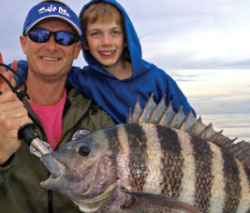The entire northwest coast of Florida Another method we use to target trout is the is known more for its speckled trout fishery than any other species. People come from all over the country to sample the trout fishing from Bayport to Steinhatchee. This is no surprise to me, since this area has miles and miles of shallow grass flats and rocky shorelines.
The most widely used method of targeting these trout is drifting a flat working a jig under a popping cork. This is a simple and effective way to catch these fish since drifting allows you to cover a large area. Typically, we would use a soft plastic like a DOA Cal Shad Tail or a Mirrolure Lil Jon on a 1/8 oz jig. You can also use live bait such as shrimp or pinfish, but these baits will also attract lots of other species that you may not want to catch. It can be frustrating at times when Sea Bass, Lizardfish and small Sharks keep eating your bait. The trout will be waiting to ambush their prey along the edges of grass lines and potholes on the flats. The noise from the popping cork gets their attention and the movement of the jig is irresistible.
Another method we use to target trout is the suspending twitch bait. These baits mimic a wounded baitfish with its erratic action. We use these on the more shallow flats along the shorelines of mangrove islands where the popping cork method would not be as effective. Having a good trolling motor to maneuver these islands will surely increase your catch since this will allow you to control the boat around the edges of these islands. The potholes and edges are much easier to see in these shallow areas. Cast into these areas and work the baits with quick snaps of the rod tip for the best results.
The third way that we target trout is with a jig and scented soft plastic bait without a cork. We use this mostly along the edges of rocky shorelines and large oyster bars that have deep cuts along their edges. This method is most effective in the late fall and early winter months when water temps
dip down in the low 60’s. The metabolism of these trout slows down dramatically as the water temperatures drop. The scented baits give you the extra time needed to let the fish have the opportunity to eat the bait. I try to give it a standing 3 count before setting the hook since these fish eat more slowly than in the warmer months.
If your target is big over slot “gator” trout, then there is no better way to catch them than in mid to late winter in the extreme shallow flats of the back-country. There is no need for hitting the water at the crack of dawn in these cold conditions, since this type of fishing is very dependent on good sunlight. Large trout like to creep onto these dark bottom flats to get warm when the sun is at its peak. The water temperature on these shallow flats can be up to 10 degrees warmer than the surrounding waters, because the high sun warms the shallows much faster than the deeper water. Another thing to note is that the fish that are found on these flats are going to be very big. Smaller fish will avoid these shallow flats for fear of predation from Ospreys and other large predatory birds.
These fish are extremely wary of their surroundings so stealth is very important while targeting them. I like to use un-weighted elongated baits like a DOA 5.5 Cal or even a 7” plastic worm like you would use for bass fishing. Natural colors work best in this situation. A slow and natural presentation is also the key to a successful trip. Light line for long casts and light fluorocarbon leader for stealth is a must. 8 pound braid and a 36” section of 15-pound leader works well.
If you would like to try and catch trout or any other inshore species in the Big Bend, please do not hesitate to give me a call.
TallTales Charters – Captain Marrio Castello 352.454.7719 – www.talltaleschartersfl.com





